#Kem Kem fossil
Explore tagged Tumblr posts
Photo

Mosasaur Tooth Fossil in Matrix – Cretaceous Kem Kem Basin Morocco, Genuine Dinosaur-Age Specimen
A superb Mosasaur Tooth Fossil embedded in its original matrix, discovered in the Kem Kem Beds of the Cretaceous Period, near Khouribga, in the Kem Kem Basin, Morocco. This authentic specimen represents a tooth from one of the top marine predators of the Late Mesozoic era.
Mosasaurs were large marine reptiles closely related to modern monitor lizards and snakes. They dominated the seas during the Late Cretaceous, preying on fish, ammonites, and other marine life with their powerful jaws and robust conical teeth.
Fossil Type: Marine Reptile Tooth (Mosasaur)
Genus: Indeterminate Mosasaur (family Mosasauridae)
Geological Age: Lower Cretaceous – Aptian Stage (~125–113 million years ago)
Formation: Kem Kem Beds, Kem Kem Basin, Morocco
Depositional Environment: The Kem Kem Beds were formed in a river-dominated deltaic environment with periodic marine incursions. This rich ecosystem supported a diverse assemblage of both terrestrial and aquatic fauna, including dinosaurs, pterosaurs, fish, and marine reptiles like mosasaurs.
Morphological Features:
Thick, conical tooth with slight curvature
Well-preserved enamel and root (where present)
Naturally set in original sedimentary matrix for display
Notable:
Excellent example of a Cretaceous apex predator’s fossil tooth
Embedded in matrix for an authentic geological presentation
Perfect for collectors, educators, and fossil enthusiasts
The exact specimen in the photo is the one for sale
Authenticity: All of our fossils are 100% genuine natural specimens and are provided with a Certificate of Authenticity. The scale cube shown equals 1cm – please refer to the image for full sizing.
This Mosasaur tooth fossil from the Kem Kem Basin offers a direct connection to one of the most formidable marine reptiles of the dinosaur age—a fascinating and educational piece of ancient natural history.
#Mosasaur tooth fossil#fossil tooth in matrix#Kem Kem fossil#Cretaceous marine reptile#Moroccan Mosasaur tooth#dinosaur era tooth#tooth fossil Morocco#prehistoric predator fossil#reptile fossil Aptian#authentic Mosasaur fossil#collector fossil tooth#Kem Kem Beds fossil
0 notes
Text
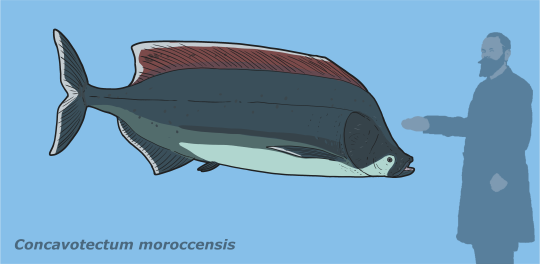
Spinosaurus drama is cool and things, but do you know what's even cooler? Better fossils of animals that lived with Spinosaurus!
There is a new specimen of Concavotectum currently on display in Tuscon. BigSkyFossils took some photos of it and I had to doodle it! It's been a while since I did a tselfatiform and now we have finally an idea how the postcranium looked like!
So far we only had a few fragments and this pretty good skull. As some people noted though, the eye is reconstructed in the wrong corner.

#sciart#paleoart#paleostream#palaeoblr#cretaceous#spinosaurus#kem kem#morocco#fossil fish#concavotectum
4K notes
·
View notes
Text
sometimes i wake up and i remember that I LOVE DINOSAURS !!!!!! RAAAAGHHHH !!!!!!! anyways anyone else ever think about the kem kem beds. because i do.
kem kem beds save me. save me kem kem beds. the disproportionate split between large herbivores and megatheropods enamors me. what do you mean theres just only sauropods and no other large herbivores. what do you mean theres like 20 different large theropod species running around at the same time. why are there fish that damn BIG. what even are noasaurids. also spinosaurus is here.
kem kem group so fine kem kem group divine. my roman empire is thinking about how the ecosystem of the kem kem beds was so incredibly diverse that it allowed for all of these different VERY LARGE carnivores to coexist because they all occupied different niches in the environment. which just totally crumbles the stereotype of Big Theropod Deathmatch because uh yeah, sorry jw bros, we have proof of some of the largest theropods in history all living in the same place at the same time!!! successfully!!! animals do not just go around beefing and fighting one another 24/7, especially carnivores. carcharodontosaurus and spinosaurus are not fistfighting everytime they see one another. spinosaurus is busy sleeping like a log on the riverbank and carchar is just coming by to get a drink. carchar accidentally steps on spino's tail and the spino snaps at it but misses completely because its half asleep and stupid. carchar walks away. they are just animals !!! and every ecosystem is incredibly complex and i love that even though we only have fossils and rocks to go off of this fact is SO evident across the globe but kem kem beds is so special to me. in my heart. anyways very rough sketch to go along with this train of thought.
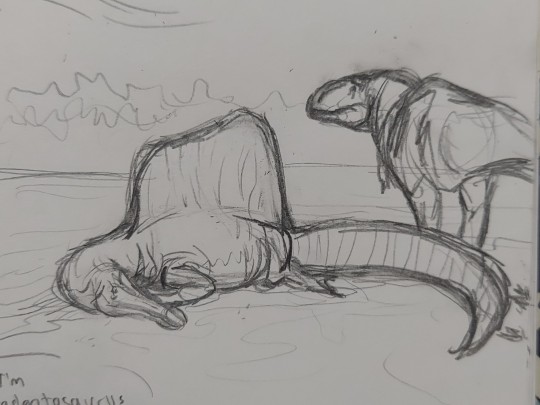
i miss you kem kem beds. sighs dreamily
#dinosaur#dinosaurs#paleontology#paleoblr#fossils#spinosaurus#carcharodontosaurus#sigh#i miss u kem kem group .... every day#dinosaurs being treated like any other animal ... something i savor more than anything#rodtalks
102 notes
·
View notes
Text

A pair of fossilized vertebrae of an indeterminate theropod, possibly an abelisauroid from the Kem Kem Group in Taouz, Morocco. It's hard to say what species it belongs to, whether it is an abelisaurid or a large nosasaurid, or something else entirely. Cf. Rugops primus and Deltadromeus agilis are possible contenders assuming the latter is a true noasaurid. There is some typical Moroccan glue that slathered onto the specimen that is difficult to remove without damaging the bone, but for the most part, it seems mostly natural.
#fossils#dinosaur#paleontology#palaeontology#paleo#palaeo#rugops#deltadromeus#abelisauridae#noasauridae#theropod#cretaceous#mesozoic#prehistoric#science#paleoblr#デルタドロメウス#ルゴプス#アベリサウルス科#ノアサウルス科#恐竜#化石#古生物学
9 notes
·
View notes
Text
Fish of the Day
Today's fish of the day is the Freshwater Plesiosaur!
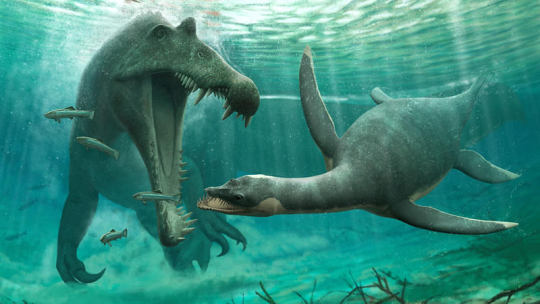
The freshwater plesiosaur was requested by Jasper, thank you Jasper! Plesiosaurus as a marine reptile, well known for their prowess as apex predators, but freshwater plesiosaurs are a relatively new idea. Based on the finding of a couple of fossils in what is now Morocco's Sahra desert river system, specifically an area called the Kem Kem beds. These fossils are scattered, showing us that this is not just the bones of one animal but a group of freshwater plesiosaurs that lived in the area, at least a dozen of them. The finding of many teeth in particular shows that these animals didn't just swim in from the ocean temporarily, but lived in the area long enough to shed teeth. This has led to some theories that the popular cryptid, The Loch Ness Monster, may be a freshwater plesiosaur, although no fossils have been yet found in that area. Although this does not confirm their existence it raises a strong argument for them. However, with limited knowledge about them for the time being, let's go over plesiosaurs in general!
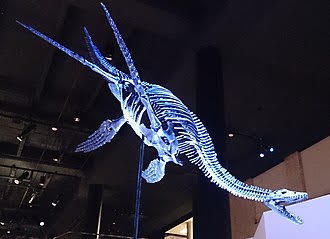
Found and named in the early 1800's the plesiosaur, from order Plesiosauria, is thought to have first appeared in the late Triassic Rhaetian stage, about 203 million years ago. These animals went extinct about 66 million years ago, to the Cretaceous-Paleocene extinction event. How they swam is still up for debate, many favor the theory that they had wide range with each of their fins, and had identical strokes, but other theories are that they may have used only the fore or hind fins for locomotion, or perhaps used them in reciprocal movement. Similar debate exists for how these animal may have dived, although we know they dived for food, as signs of decompression sickness have been found. As apex predators they ate through anything they could get close to, small fish, larger fish, sharks, cetaceans, crustaceans, one another. It is found that although they were certainly near the top of the food chain, some of them were still occasionally prey for large sharks, but mostly they fell to one another, larger plesiosauria hunting smaller. It is thought they evolved to fill the niche left open by the extinction of Ichthyosaurs, which died out in the late Cretaceous, and allowed for diversification to take place in Plesiosauria. Plesiosauria during this era evolved two distinct morphological types: the pliosauromorph build, the Pliosauroidea family, and the plesiosauromorph build, the Plesiosauroidea family.
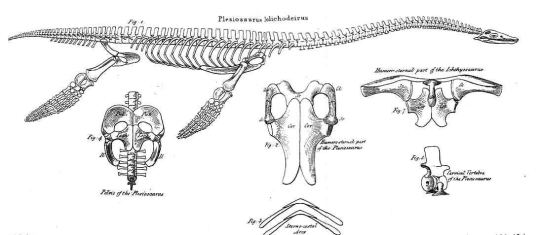
Pliosauroidea is defined by their large heads and short necks, often compared to the build that crocodiles have. They are also known for having larger hind flippers than other plesiosaurs and can be found mostly across South America, and along the equator, although some fossils have been found as far north as Norway. The largest genus found so far, the Liopleurodon, is as large as 6 feet 5 inches, or just a little under 2 meters.

Plesiosauroidea was defined by the long skinny neck, which was used to hunt in small holes, and could move fast to snap up small marine animals nearby them. Although Plesiosauroidae is often depicted as a fast moving predator, it is found that they were likely slow swimmers, pushing their way through the water similar to the swimming methods of turtles, staying close to the surface and using their four limbs for mobility, making it easy to snap at nearby animals. Despite the common displays of them in swan-like positions, with the head raising out of the water, this is unrealistic, as they could not raise their heads up to a degree like that, and the weight of the muscles would prevent them from surfacing. The size difference between differing species was huge, as some could be only as large as 3 meters to 20 meters in length. It is currently thought that the freshwater finds belong to Plesiosauridea.
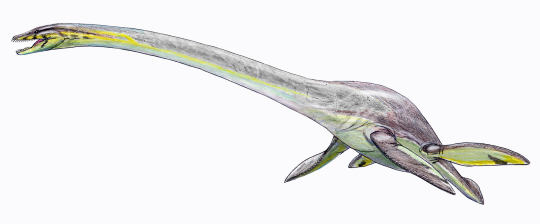
Everyone have a good day!
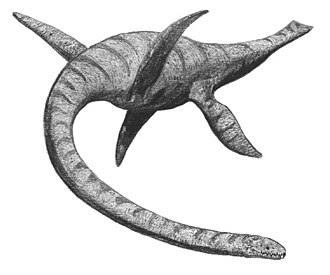
#fish#fishblr#fishes#fishposting#aquatic biology#aquatic#marine biology#ichthyology#marine animals#marine life#freshwater#freshwater fish#animal#animals#animal facts#fish of the day#information#education#nature#river#paleo#paleontology#plesiosaur#plesiosaurus#freshwater plesiosaur#Plesiosauria#Pliosauroidea#Plesiosauroidea
29 notes
·
View notes
Text
[VERY IMPORTANT UPDATE TO ALL THIS AT THE BOTTOM]
Sometimes I just think about how petty the conversation around theropods can get in a way that no other group of dinosaurs seems to spark. And this toxic obsession with size is starting to bleed over into actual scientific conversation, which I believe is more important than any of my ramblings. Skip past all of this and go to the end if you must, I want more people to read at least the excerpt of the paper and be aware of this growing issue in paleontology.
Sauropods? Stegosaurs? Hadrosaurs? Pachycephalosaurs? No other dinosaur group seems to spark as much vitriol and internet slap fighting as the theropods do. Specifically the “mega”theropods as they’ve been dubbed more recently in the online paleo-sphere. T. rex, Spinosaurus, Giganotosaurus, you know the type. Big bodies with big heads with big jaws that certain sects of paleo fans get a bit too excited arguing over.
Of course most of these arguments center around the tyrant lizard king itself. A beast that I don’t need to bother doing this introduction for because you all know it’s coming: Tyrannosaurus rex. I know there’s a good too many people who treat T. rex as this unstoppable monster, God’s chosen creature among the other lowly fleshbags of the Mesozoic. Every new paper that comes out about Tyrannosaurus seems to just embolden them even more, especially now with that paper a few months back suggesting T. rex even larger than those preserved in the fossil record likely existed.
I’ve always found the rat race surrounding the size of T. rex and other “mega”theropods to be inherently a bit comical. If they want insanely large dinosaurs so badly I would point them towards sauropods, but those didn’t actively kill other dinosaurs so who cares amirite? Every other group of dinosaur, every other animal ever to evolve, only exists for the sake of power scaling their beloved giant theropod of choice.
But my question is doesn’t all this get a bit boring after a while? Acting like “mega”theropods were these untouchable gods and every other animal in the history of evolution is just a joke by comparison, it’s a frankly juvenile way of seeing things.
Triceratops? Only exists to have its head ripped off by and be a cool opponent for T. rex. Diplodocus? Only there so a gang of Saurophaganax can rip it apart. Rebbachisaurus? Tf even is that? The Kem Kem Beds were just the thunder dome for all those huge African theropods and crocodiles to beat each other up.
Point is I find the constant discussion and resulting arguments over theropod size and strength to be repetitive and boring. These “mega”theropods were no doubt powerful and fascinating animals, but they weren’t kaiju. They don’t need to be unkillable gods to still be worth appreciation and respect. Imagining them as the animals they were is much more stimulating for me than the simple who was the biggest back-and-forths.
———————————————————————————
(edit) this is a massive update in this particular subject, please, if not the rest of my ramblings at least read this:
I’d like to end with an excerpt from a scientific paper published just today by Joel H. Gayford et al. concerning size estimations of extinct animals
“Furthermore, one must be aware of backlash from the ever-growing fan communities of prehistoric organisms (such as Dunkleosteus, O. megalodon and theropod dinosaurs) on the internet, who may feel strongly about the perceived appearance of their favourite organisms. None of these concerns are hypotheticals, and all have happened at one point or another to many palaeobiologists who study well-known, iconic fossil taxa, including some of those mentioned in the present study. All studies should be judged on their scientific merit through debate and discourse, through which progressive improvements to our understanding of extinct animals can be gained.”
You can read the paper for yourself, as it’s publicly available for free: https://onlinelibrary.wiley.com/doi/1...
This is more than simple online slap fighting. It’s affecting real paleontology. If actual scientists are now wanting to avoid certain species because of these types of paleo fans I don’t even know what to say. The paper goes in-depth about the problems, both scientifically and socially, that arise when determining the mass of an extinct animal. And I couldn’t agree more. I hate to beg for shares but if you can, and want to help push back against the awesomebros choking out real paleontologists then please consider it!
#social justice#current events#paleontology#paleomedia#science#science tumblr#science side of tumblr#dinosaurs#dinosaur#youtube#youtube community#important#important to know#jurassic world chaos theory#jurassic park#jurassic world camp cretaceous#jurassic world: dominion#jurassic series#prehistoric planet#jurassic world rebirth#jurassic world fallen kingdom#fandom#youtube comments#prehistory#history#history posting#history tumblr#history side of tumblr#history lover#science communication
3 notes
·
View notes
Text
file : interesting creatures (#1): spinosaurus !
info requested by anon! rhykar copypasted the ENTIRE spinosaurus fun facts post in our drafts onto this post; therefore, thank us both for this one!
the spinosaurus aegyptiacus was a spinosaurid dinosaur that lived in what is now north africa, its reign taking place in the mid and late cretaceous period around 93.5 to 110 million years ago, in the cenomanian and albain ages. it went extinct near the end f the cretaceous period.
the spinosaurus aegyptiacus' habitat consisted mostly of mangrove forests and tidal flats (muddy, marshy areas of mostly flat land that tend to be covered in sea or delta water). most of the area it lived in included the land that now harbors egypt and morocco.
spinosaurus fossils have been found in egypt, morocco, tunisia, libya, kenya and algeria, in the bahariya formation (egypt)*, aoufous and tegana formations [kem kem beds] (morocco), chenini formation (tunisia), cabao formation (libya), turkana grits formation (kenya), and gara samani, algeria, as well as the ain el guettar formation, also in tunisia. (fossils of similar spinosaurid have been found in thailand, southern england, brazil, niger, laos, and the isle of wight, among others. pelvic bones and vertebrae found to belong to the spinosaurus aegyptiacus have also been found on the isle of wight.)
the first spinosaurus aegyptiacus fossils were found in the bahariya oasis, in the western egypt desert! these fossils were discovered in 1912, and the spinosaurus was named by paleontologist ernst stromer. the original remains were destroyed in world war 2, on april 24th, 1944.
"spinosaurus" translates from latin. it literally just means "spined lizard."
as is generally obvious knowledge, jurassic park was ridiculously inaccurate. there's a lot, but here's a few!
1: the spinosaurus in the movie had inaccurate jaw strength; a real spinosaurus, who would probably have never even encountered a tyrannosaurus rex, would never have had to adapt to develop a bite force strong enough to break a nearly fully-grown tyrannosaur's neck. (probably not any tyrannosaur- not just the rex.)
2: the nasal horn on the spinosaurus in the movie was unrealistically sharp; paleontology has generally shown that it was probably more blunt.
3: the lacrimal ridges on the spinosaurus in the movie were too small for a spinosaurus the age of the one in the movie. a scientific accuracy would have shown a spinosaurus with a much bigger and more developed set of lacrimal ridges.
4: it is trivial knowledge that the spinosaurus aegyptiacus was bigger than the tyrannosaurus rex; the one in the movie was barely a handful of inches taller than the tyrannosaurus rex it killed; that tyrannosaurus rex was also a juvenile.
we used to nearly collectively think that the spinosaurus hunted in deep rivers and on ocean shores, but recent studies have shown substantial evidence that the spinosaurus was more like a gigantic, evil, probably very smart reptilian heron from hell.
spinosaurus most likely spent more time on the river shores of their north african habitats than inland. evidence of this conclusion includes: a) its nostrils are positioned toward the middle of its snout, suggesting it could mostly submerge itself in order to hide from territorial rivals. b) its pelvis was smaller than most other large carniverous theropods, which suggests that it used the things attached to said pelvis, the tail and hind legs, to chase after quick-moving small riverside creatures and assist itself in submerging into rivers when it had to hide. c) the vertebrae of its tail was also oddly loosely connected, which suggests it used it as a sort of balance to swim or run after riverside prey rather than using it as an aid in deep-sea plunder.
recently discovered evidence suggests that the spinosaurus may have been covered in a skin membrane that could change color, which would have assisted in temperature regulation in cold rivers and potentially have aided in attracting mates and intimidating other dinosaurs. the membrane may have also enabled the spinosaurus to act something like the indominus rex, changing its color to camoflauge itself with its surroundings to hunt, or to hide if a water source was not available or safe to hide in.
we used to think the spinosaurus's sail was used solely for swimming and temperature regulation. but recent discoveries seem to suggest otherwise- the sail may have been used for social displays or species recognition. some also believe the sail was used to store water and lipids in case a river any individual spinosaurus lived near began to dry up.
*1: the particular location mentioned, in more specifics, would be the bahariya oasis in the western desert of egypt.
sources : the dominating source i'd like to give credit to for the information in this post is rhykar, my lovely nerdy professional ghost hunting boyfriend, fellow owner and creator and primary organization person of this account!
send an ask if you want more info, or if you've got more to share! please use this post as a source if you post or use information you found on it!
#+ file : creatures#+ subfile : dinosaurs - spinosaurus#+ researcher : hayle#dinosaurs#spino#spinosaurus#spinosaurus aegyptiacus#fun facts#jurassic park#jurassic park inaccuracies#africa#african dinosaurs#prehistory#prehistoric creatures#spinosaurus facts#dinosaur facts
3 notes
·
View notes
Text



Fossil crocodylomorph jaw section. Kem Kem.
2 notes
·
View notes
Text
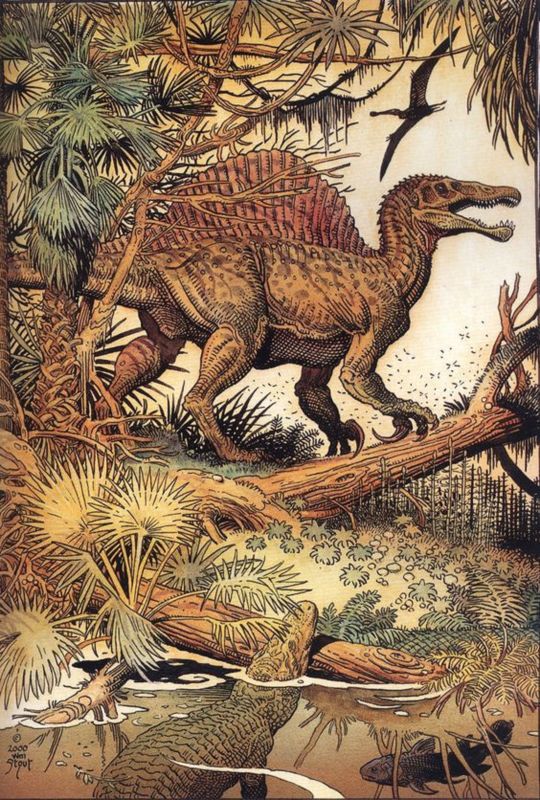
SPY-noh-SOAR-uss -- THE "SPINY LIZARD" OF PRESENT DAY NORTH AFRICA.
PIC INFO: Resolution at 1692x2508 -- Spotlight on Spinosaurus (meaning "spine lizard"), a genus of theropod dinosaur that lived in what now is North Africa during the upper Albian to upper Turonian stages of the Cretaceous period, about 112 to 93.5 million years ago.
The best known species is S. aegyptiacus from Egypt, although a potential second species, S. maroccanus, has been recovered from Morocco. Artwork by William Stout, c. 2000.
Name: Spinosaurus (Spine lizard)
Phonetic: Spine-oh-sore-us.
Named By: Ernst Stromer - 1915.
Synonyms: Sigilmassasaurus?
Classification: Chordata, Reptilia, Dinosauria, Saurischia, Theropoda, Megalosauroidea, Spinosauridae, Spinosaurinae.
Species: S. aegyptiacus (type), S. maroccanus is a possible second, although many consider this species as being the same as the type species.
Diet: Piscivore/Carnivore.
Size: Estimates highly variable amongst sources and range anywhere between 12.6 and 18 meters total body length. Skull length estimated between 1.5 and 1.75 meters long.
Known locations: North Africa, particularly Egypt - Bahariya Formation, and Morocco - Kem Kem Beds.
Time period: Albian to Cenomanian of the Cretaceous.
Fossil representation: To date at least six partial specimens of the skull, mandible, neural spines and other fragmentary post cranial remains. Teeth however are considerably more common.
Sources: www.prehistoric-wildlife.com/species/s/spinosaurus.html, www.mindat.org/taxon-4967112.html, & Pinterest.
#Spinosaurus#William Stout#Dino Art#Spinosaurus Aegyptiacus#S. aegyptiacus#Theropod#Dinosaurs#Late Cretaceous#William Stout Art#Paleoart#Dinosaur Art#Spinosaurus aegypticus#Spinosauridae#Prehistoric#Prehistory#Prehistoric Creatures#Prehistoric Animals#William Stout Artist#Palaeoart#Palaeo Art#Dinosaur#Illustration
6 notes
·
View notes
Text
Discover Rare Abelisaur Fossils with Fossil Age Minerals – Unearth Prehistoric Wonders Today!
Abelisaurid is known as the Kem Kem Abelisaur; is a genus and species of large, Abelisaurid, discovered in Northern Africa; Kem Kem Beds. It was a larger species of Abelisaurid, as studying the fossilized dinosaur bone from Morocco, the paleontologists deduced that this Abelisaur may have been 9 to 10 meters long and weighed about 2,000 kg. The Abelisaur lived around 95 million years ago (late Cretaceous period) in what is now North Africa, which at that time was a lush savannah criss-crossed by delta-rivers and huge mangrove swamps. Explore more:- https://www.fossilageminerals.com/collections/abelisaur-fossils

#dinosaur fossils#ammonite fossils#mammal fossils#fossils#buy real fossils#spinosaurus fossils#dinosaurs#chasmosaurus fossils#fish fossils
0 notes
Note
I can't stop thinking about the Predacon bones now. It really makes no sense that they're strewn about like they shot out of a bone geyser.
jhsfgdjhsgjg ok that is the single funniest way u could have put it lmfao. "shot out of a bone geyser"
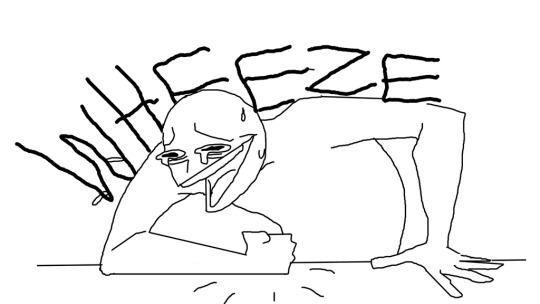
AND YEAH!! honestly the whole predacons plot makes only about 50% sense; predaking and the cloning? i buy that. predacon 'bones' on earth? blatantly an excuse for more artifact hunting. Everything about the strewn bones and rising zombies on Cybertron? NOPE.
1) the predacons went extinct in the Cataclysm, where Cybertron got hammered by loads of enormous meteorites over a fairly long period of time. chances are good that their remains are either buried under a shit ton of ejecta from later strikes OR they got a Direct Hit and are now like some weird isotopic signatures or blobs of metal inside a whole lot of shocked structures or impact breccia, or whatever the fuck else happens when u strike a metal planet with miles-wide space rocks traveling at 30km/s.
2) what they should have done was go for a tanis hell creek formation type thing. Imagine: corpses trapped for eternity inside a jumbled mass of impact debris, exposed for the first time in the scarps of newly-made faults. Wouldn't that be dramatic? :D
3) the predacons' wings stretch my suspension of disbelief in general but SOME OF THOSE FUCKIN ZOMBIES HAD NO WINGS!!! AND UR TELLIN ME THEY FLY?? bullshit!!
#good end au where none of That Bullshit happens and instead autobot scientists are like#'hey predaking i bet we could take some of these fossils and clone u a family'#kem watches tfp#predacons rising#cybertronian earth sciences
13 notes
·
View notes
Photo

Mosasaur Tooth Fossil in Matrix – Cretaceous Kem Kem Basin Morocco, Genuine Dinosaur-Age Specimen
A superb Mosasaur Tooth Fossil embedded in its original matrix, discovered in the Kem Kem Beds of the Cretaceous Period, near Khouribga, in the Kem Kem Basin, Morocco. This authentic specimen represents a tooth from one of the top marine predators of the Late Mesozoic era.
Mosasaurs were large marine reptiles closely related to modern monitor lizards and snakes. They dominated the seas during the Late Cretaceous, preying on fish, ammonites, and other marine life with their powerful jaws and robust conical teeth.
Fossil Type: Marine Reptile Tooth (Mosasaur)
Genus: Indeterminate Mosasaur (family Mosasauridae)
Geological Age: Lower Cretaceous – Aptian Stage (~125–113 million years ago)
Formation: Kem Kem Beds, Kem Kem Basin, Morocco
Depositional Environment: The Kem Kem Beds were formed in a river-dominated deltaic environment with periodic marine incursions. This rich ecosystem supported a diverse assemblage of both terrestrial and aquatic fauna, including dinosaurs, pterosaurs, fish, and marine reptiles like mosasaurs.
Morphological Features:
Thick, conical tooth with slight curvature
Well-preserved enamel and root (where present)
Naturally set in original sedimentary matrix for display
Notable:
Excellent example of a Cretaceous apex predator’s fossil tooth
Embedded in matrix for an authentic geological presentation
Perfect for collectors, educators, and fossil enthusiasts
The exact specimen in the photo is the one for sale
Authenticity: All of our fossils are 100% genuine natural specimens and are provided with a Certificate of Authenticity. The scale cube shown equals 1cm – please refer to the image for full sizing.
This Mosasaur tooth fossil from the Kem Kem Basin offers a direct connection to one of the most formidable marine reptiles of the dinosaur age—a fascinating and educational piece of ancient natural history.
#Mosasaur tooth fossil#fossil tooth in matrix#Kem Kem fossil#Cretaceous marine reptile#Moroccan Mosasaur tooth#dinosaur era tooth#tooth fossil Morocco#prehistoric predator fossil#reptile fossil Aptian#authentic Mosasaur fossil#collector fossil tooth#Kem Kem Beds fossil
0 notes
Note
Are there any theories as to why we don’t find big Ornithopods in deposits like Candeleros or the Kem Kem? We have their footprints and body fossils of other large dinosaurs from those places.
Ahhh, good question. I haven't looked that much into this but to my knowledge there isn't really an answer for this.
There could be several reasons, the easiest is that we just haven't found them yet, which is more likely than you think. Another is taphonomy. Maybe something about these ornithopods made them less likely to preserve.
It is also possible that these animals were simply rare in these environments and only occasionally visited.
Maybe it was all of these combined...
Really hard to say. When we finally get a ornithopod from Kem Kem we might learn more.
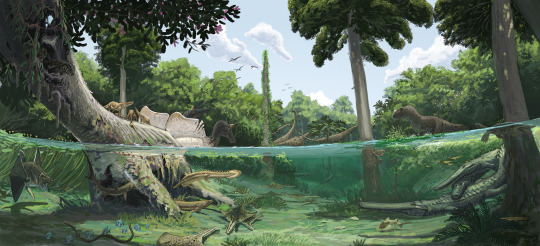
70 notes
·
View notes
Text
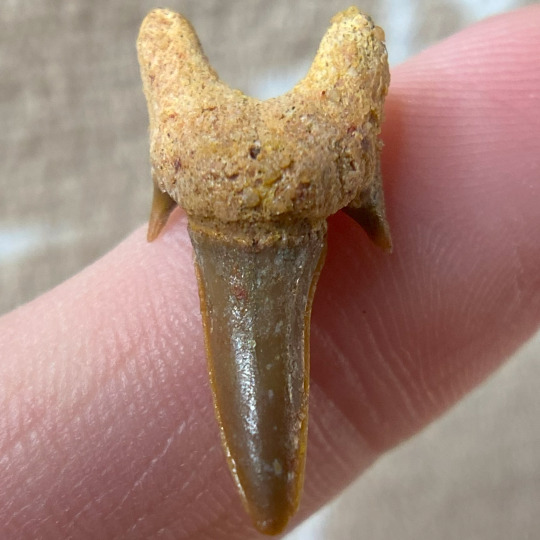
A fossilized shark tooth of a Leptostyrax macrorhiza from the Kem Kem Group in Taouz, Morocco. This species of lamniform or mackerel shark appears to have been tolerant of fresh or brackish water along with other true shark species such as Haimirichia amonensis and Cenocarcharias tenuiplicatus. These sharks may have encountered piscivorous dinosaurs like Spinosaurus and Sigilmassasaurus.
#fish#shark#chondrichthyan#fossils#paleontology#palaeontology#paleo#palaeo#leptostyrax#pseudoscapanorhynchidae#cretaceous#mesozoic#prehistoric#science#paleoblr#fossil friday#fossilfriday#レプトスティラックス#プセウドスカパノリンクス科#サメ#化石#古生物学
4 notes
·
View notes
Photo

Dino 2: Spinosaurus
crocodile lookin ass get tf outta here
Reblogs > Likes !
#spinosaurus#Spinosaurus aegyptiacus#dinosaur#dino#dinosaurs#pterosaurs#xericeps#reptile#flying reptile#design#dino design#accurate spinosaurus#spinosaurs#theropod#paleoblr#dinoblr#paleontology#kem kem beds#fossil
46 notes
·
View notes
Text
Morocco 2019
Our busy autumn season continues! Here's the blog of our recent trip to Morocco.
Morocco: The Trilobite’s Sahara Kingdom
In November 2019, we returned to Morocco to run our Trilobite’s Sahara Kingdom tour for the fifth time.

GeoWorld Travel’s ‘Morocco: The Trilobite’s Sahara Kingdom’ route map
Day one – arrival
The tour group gathered at our hotel in Marrakesh today. We welcomed guests from the UK, the USA and the Netherlands. We enjoyed a traditional Moroccan…
View On WordPress
#4x4#alnif#berber#crinoids#desert#desert adventure#devonian#Dinosaurs#fossil#fossil collecting#fossil hunting#Fossils#geology#geology holiday#geology tour#geotour#geotourism#kem kem#marrakesh#merzouga#Morocco#off-road#ouarzazate#sahara desert#trilobite#trilobites
2 notes
·
View notes